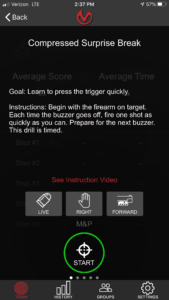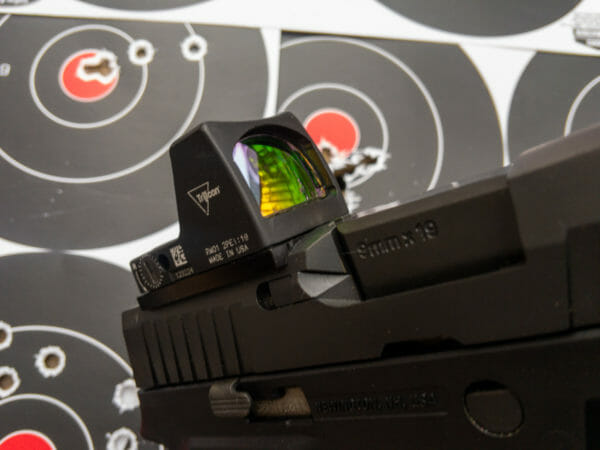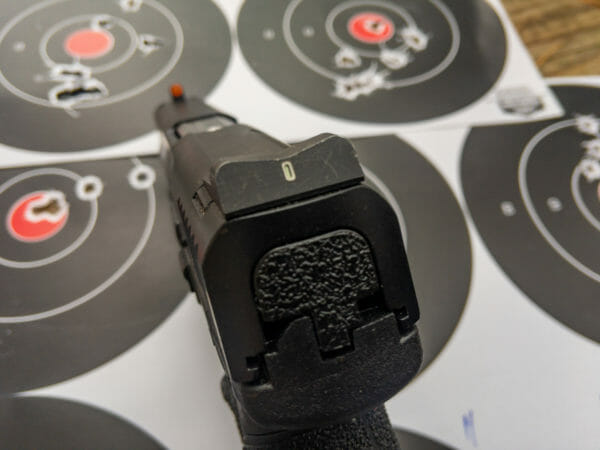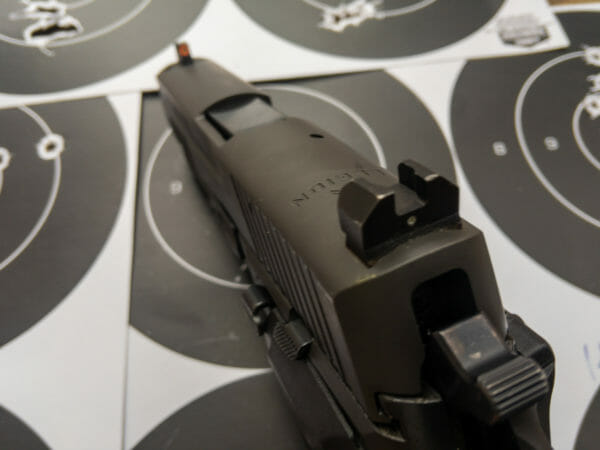Tom breaks down three basic styles of handgun sights: express, post and notch, and red dot to find out which one is the best handgun sight?

USA – -(AmmoLand.com)- One of the easiest things to personalize on a handgun is the sight system. There are a zillion sighting options on the market, each promising to be the ideal solution, so how do you decide? You’ll find post and notch solutions, fiber optics, u-notch, straight eight, and red dots, just to name a few. Heck, there are even solutions that have you stacking triangles, hexagrams, or some such shapes on top of each other.
Testing to Fund Best Handgun Sights
Choosing the best solution for your particular needs isn’t at all helped by the gun counter aphorisms passed along like holiday fruitcakes.
“How many world champions do you know that use express sights?”
“Most self-defense encounters happen in the dark.”
“You’ll still be looking for that electronic red dot long after your killed and buried.”

What these pithy sayings generally ignore is the intended use of the solution that’s being promoted or disparaged. If I want to win an NRA Bullseye competition, I probably wouldn’t choose express sights. If my goal was to hit an armed and charging attacker in low light conditions, I wouldn’t choose blacked-out post and notch sights.
You get the idea. The gun sight application determines the features that are important.
My primary “firearms use case” is self-defense, so I’ve been doing all manner of experiments with different gun sight types to figure out what works for me. Oh, and my eyes aren’t nearly as sharp as they used to be, hence the urgency to settle on something that works. Ten years ago I could use any sight design just fine. Now, I find that I’m spending more time finding the sight and getting a proper sight picture once the gun is raised than I am drawing my gun from concealment. Sighting has become the slowest part of the sequence.
I decided to put the nifty new Mantis X10 device to good use and do some timed sighting and shooting with three basic styles of handgun sights: express, post and notch, and red dot. There are far more variations on those than I can cover here today, so I view these as representative of broad categories.
Related: MantisX Firearms Training System App and Sensor Review
To do this, I leveraged one of the built-in drills of the Mantis X10 system, the Compressed Surprise Break. The intent of this scenario is to test and develop your ability to fire a quick shot without jerking the trigger from a ready, finger on the trigger, sights-on-target position. The app beeps then detects the shot, telling you the time elapsed and analyzing gun movement before, during and after the shot break. However, since it doesn’t care how much time you take, I used it a bit differently.
Starting with the muzzle pointed at the ground, finger of the target, and eyes focused on the target, I used it as a single shot timer to gauge the time to acquire the sights and fire the shot. Eliminating the draw took many variables out of the equation. I also placed the target 15 yards away and forced myself to get a precise shot picture before firing a shot, so there were no misses. When going for pure speed at closer targets, it’s easy to do a rough alignment using the slide of a partial sight picture and I wanted to eliminate that. I ranked reasonable precision over the fastest possible speed regardless of hit outcome.
I used three 9mm pistols with different sight configurations.
Sig Sauer P320 XCompact – Trijicon RMR Red Dot Sight
The new XCompact ships with a removable plate for an optics mount on the slide. As I’m still waiting for a Romeo1 PRO, I used a third-party adapter plate to mount the Trijicon RMR. It’s a fine solution, but there is no co-witness capability. The Romeo1 PRO sits a bit lower in the slide and has a built-in notch that serves as a rear iron sight. This is an “always on” red dot solution, so it’s appropriate for defensive use—there’s no need to turn anything on. The other drawback of the RMR solution is that the window is a bit smaller so there can be a “find the dot” delay. That’s mostly mitigated by technique and focusing on looking for the front sight instead. When you do that, the dot tends to appear on its own.

Smith & Wesson M&P 2.0 – XS DXT2 Big Dot Sights
The DXT2 Red Dots are the latest iteration of the classic XS Big Dot sight solution for handguns. Modeled after dangerous game rifles, these sights have a huge dot up front paired with a shallow “V” ramp in the back. The result is that they’re fast. With no clutter in the rear, that oversized dot leaps into view. The dot contains a Tritium insert and bright photoluminescent paint surrounding that, so it’s visible in daylight, transitional, and dark conditions.

Sig Sauer P229 Legion – XS F8 Sights
The XS F8 sight is a classic post and notch setup with a variety of subtle but effective design enhancements that improve visibility in varying light conditions and increase speed. The front post is oversized and contains a larger dot than most traditional sights. Like the DXT2, it contains a center Tritium vial surrounded by bright photoluminescent paint, so it glows in transitional light situations. The rear sight also uses little tricks to increase speed. The bottom of the notch is cut with rounded corners. That helps draw the eye to the top corners of the notch for faster elevation alignment. There’s a Tritium dot below the center of the notch which provides a taste of the straight-eight design. The interior of the rear notch is hollowed out, so you see more daylight around the front sight. That helps you see and center it faster.

Best Handgun Sights – Conclusions
After firing and timing a bunch of shots with each setup, I did find that the XS DXT2 big dot sights were fastest overall—for me. Compared to the red dot configuration, I shot exactly 20% faster from the low ready with eyes on the target. At 15 yards, accuracy was fine, and I had no trouble keeping all shots in the interior body zone of a standard FBI QIT-99 type target with the chosen blend of “fast but accurate” shooting.
What surprised me was how close the aggregate and average times were for the DXT2 and more traditional F8 sight configurations. Those little tweaks in the F8 design make a difference because normally I find the big dot style significantly faster than factory standard sights. I was only a few hundredths of a second slower with the F8 sights than the big dots. Hold this thought for a second—we’ll come back to it.
While a bit slower for me in this particular drill, the red dot was by far the most precise and intuitive. Can you shoot one-hole groups with express or traditional post and notch sights? Absolutely. Can you do the same much more easily with a red dot? Absolutely. This drill reinforced previous findings about red dot sights. For me, it’s easier to shoot more distant targets with greater accuracy faster. That’s a mouthful, but the result is meaningful. Eliminating all those focal planes and putting a dot on the target you’re looking at is as easy as it gets. If you can press the trigger without moving the gun, you’ll get accurate hits.
Light conditions can matter—a lot. Especially as the eyes age, the amount of ambient light makes a big difference in how clearly one sees the front and rear sights and how quickly you can pick up a sight picture. I did the side-by-side comparisons at an outdoor range on a bright and sunny day, so I couldn’t perceive any real difference between the two iron sight options in terms of clarity and speed.
On the other hand, when picking up a sight picture indoors, I see a significant difference between the big dots and the more traditional post and notch F8 sights. The reduced clutter and shadowing of the huge ball and ramp sight picture of the DXT2s is much easier and faster to pick up in any conditions less bright than strong daylight. Even sitting here at my desk in the middle of the day, surrounded by open windows, the standard sights are slower to focus. It’s just a function of human eyes—they work a lot better in bright light conditions.
When choosing your best handgun sights solution, it’s important to think about your most likely use cases. For a home-defense or concealed carry gun, be sure to test the “view” indoors to see if the lower light levels still work well for you. For a competition or range plinker, you may be outside more than inside, so a more traditional sight solution might be just peachy.
As with most things, there’s rarely one correct answer.
About
Tom McHale is the author of the Practical Guides book series that guides new and experienced shooters alike in a fun, approachable, and practical way. His books are available in print and eBook format on Amazon #ad. You can also find him on Facebook, Twitter, Instagram and Pinterest.

I put the XS big dot on my P229r and my shoots have gotten much better. Im still terrible but much better.
I had cataract surgery 2 years ago so i need a really big dot for my sight picture. Lo and behold there is just such a thing.
I love it.
Great review
I have been using a Romeo1 Pro red dot on my SIG X5 Legion, and the Romeo 0 on my 365XL for about 3-4 months now. I use both for IDPA, and my EDC is the 365XL. Both are extremely accurate with the red dot, and also co witness with a built in rear sight, and the big X-Ray front sight. You get the best of all three worlds. It’s getting much faster in matches with the Romeo1 pro. The 3 MOA dot works perfect for my 64 year old eyes. Would be interesting for you to repeat this after… Read more »
I was taught on notch and post, and I will stay there, it just feels natural.
Still interesting to see the comparison though.
And how about a laser sight for the blind ? lol
An interesting study, Tom, but you have a couple of confounding variables: First, to be truly “apples-to-apples,” each of the sights should be tested on the same type of gun, thereby removing grip angle, trigger weight (in particular, I imagine the Legion is DA/SA while the other two are striker-fired), etc. Second, learning to use a reflex optic on a pistol has a considerable practice effect. Those who practice infrequently (or not at all) with the system will be much slower than those who have. I’d like to see this repeated by somebody who routinely shoots Carry Optics in USPSA.… Read more »